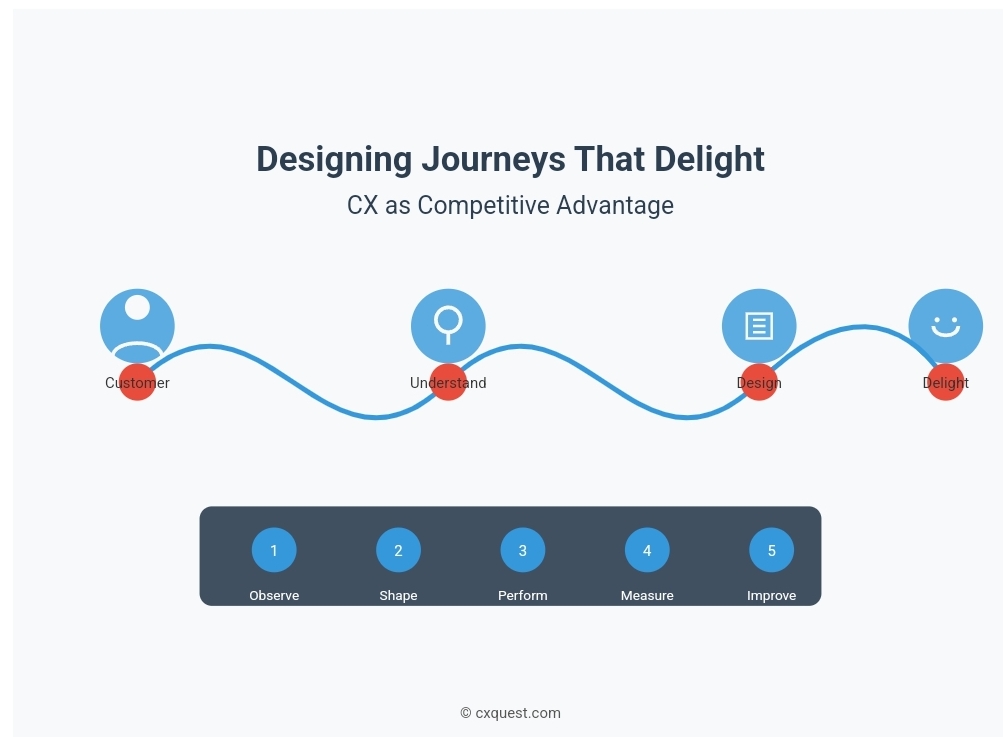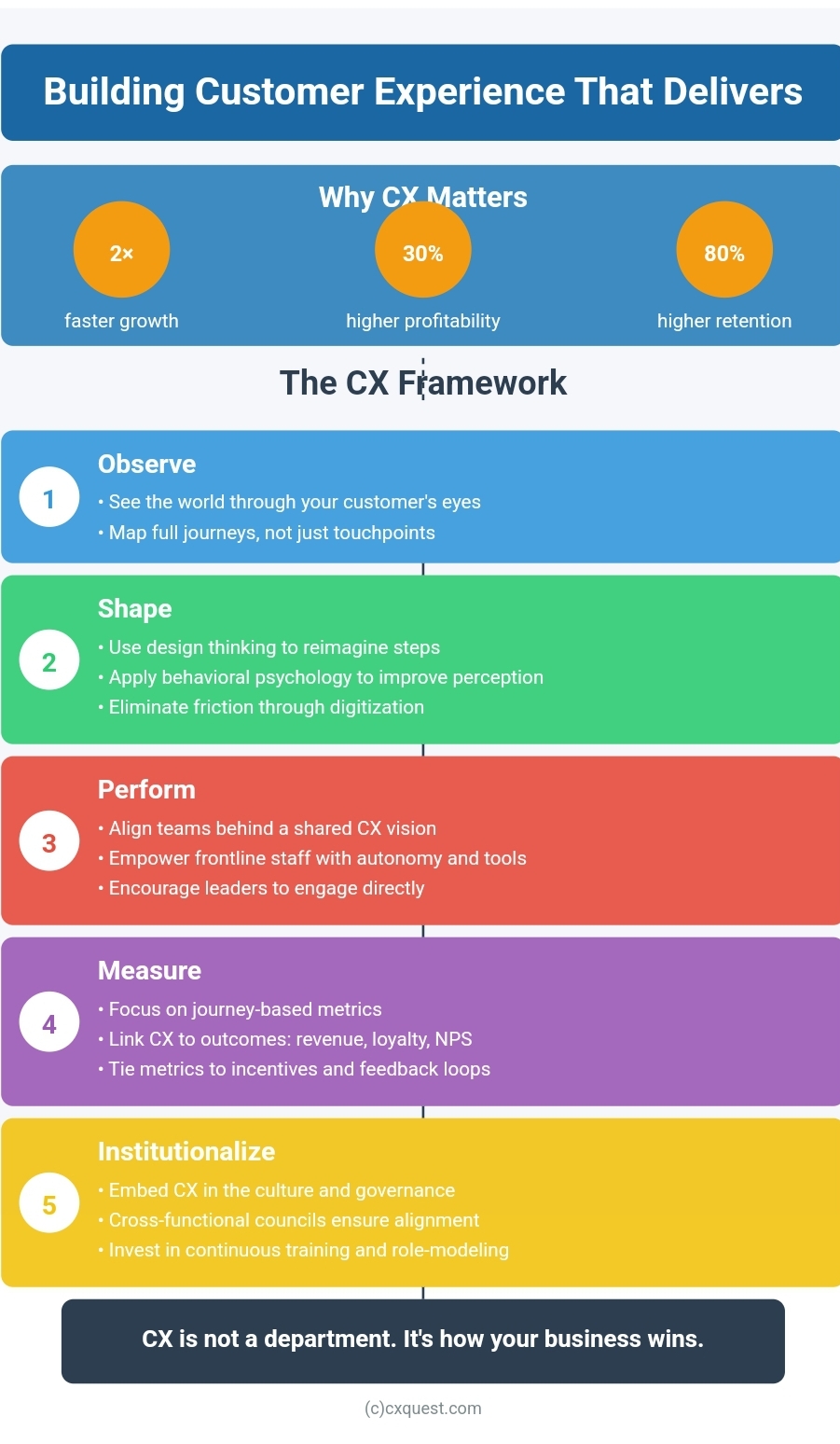Designing Journeys That Delight: Why CX Is the Future of Competitive Advantage
Customer experience (CX) is no longer optional. Neither is CX Strategy. It is a strategic imperative. Companies across industries now recognize this shift. Instead of focusing solely on products or services, leaders focus on how those offerings are delivered. Because of this, customer experience has emerged as a key differentiator.
However, building great CX takes more than good intentions. It requires a CX strategy with a structured, disciplined approach. It also demands cross-functional collaboration and an unwavering focus on the customer’s needs.
CX Strategy: Start with the Customer, Not the Product
Too often, companies begin with what they want to sell. Instead, leaders must ask, “What do customers want?” This question changes everything. It shifts the organization’s perspective. Suddenly, every department begins thinking about customer impact.
Moreover, successful companies map customer journeys, not touchpoints. Why? Because customers don’t think in silos. They think in journeys—from the first interaction to the final resolution.
For instance, even if every touchpoint performs well, the overall journey might disappoint. Conversely, a well-orchestrated journey—though imperfect at points—often wins loyalty.
CX Strategy: Observe and Understand the Customer’s Perspective
Customers today expect immediacy, simplicity, and personalization. Furthermore, they compare every experience to leaders like Amazon and Google. So, falling short—even slightly—can be costly.
To respond effectively, companies must observe customer behavior. Then, they must identify the moments that matter most. By understanding these critical moments, they can prioritize changes that deliver real value.
Additionally, data plays a key role. Advanced analytics help companies understand what drives satisfaction and what causes churn. The insights gathered shape smarter strategies.
CX Strategy: Shape the Experience with Design Thinking
Once companies understand customer journeys, they must redesign them. This process, ideally, begins with design thinking. In other words, teams should challenge existing assumptions. They should also reimagine each step from the customer’s view.
For example, one bank reduced its account opening process from six days to ten minutes. How? By removing unnecessary steps and leveraging face-recognition technology.
Additionally, companies can apply behavioral psychology. For instance, ending interactions on a high note boosts satisfaction. Likewise, combining steps can make the process feel faster.
These small but strategic changes create emotional value. And emotional value often exceeds functional value in customer perception.
Digitize with Purpose
Digital isn’t just a channel. It’s a tool for transformation. Leaders use digital to simplify experiences, reduce friction, and empower users.
Moreover, digital journeys allow rapid iteration. Agile teams can test, learn, and improve in short sprints. With each iteration, they bring the company closer to the ideal experience.
Yet digital alone isn’t enough. Companies must integrate digital with human support. The best journeys blend both, depending on the customer’s preferences and context.
Perform with Alignment and Agility
Creating a great customer experience isn’t a one-off project. It’s an ongoing journey. To succeed, organizations must align every function—from IT to HR—with the CX vision.
Frontline teams, in particular, must be empowered. They should know the company’s customer promise. More importantly, they must be enabled to deliver on it.
Leaders must walk the talk. They should engage directly with customers and frontline teams. By doing so, they foster a culture of accountability and empathy.
Measure What Matters
Measurement is critical. However, measuring only what’s easy can lead to blind spots. Instead, companies must track journey-based metrics. These should be tied to real outcomes like retention, loyalty, and revenue.
Moreover, feedback should flow in real-time. Employees at all levels should use this data to adjust behavior and processes.
In best-in-class organizations, CX metrics are tied to incentives. When employees see how their work impacts customer outcomes, engagement rises.
Institutionalize Customer-Centricity
Great CX doesn’t happen in isolation. It must be embedded in the organization’s DNA. To do this, leaders must define a clear vision. Then, they must translate that vision into principles and behaviors.
Additionally, governance is essential. A cross-functional CX council, including a chief customer officer, can oversee transformation. These structures ensure consistency and help overcome resistance.
Training also plays a vital role. Employees need both skills and mindsets to serve customers effectively. Ongoing development programs reinforce these capabilities.
Log Early Wins and Build Momentum
CX transformations take time—often two to four years. However, early wins are essential. They prove value. They inspire confidence. They create momentum.
Therefore, leaders should choose initial projects that deliver measurable results. These could include digitizing a painful journey or redesigning a common process.
Once success is visible, teams can scale their efforts. Over time, CX excellence becomes a habit, not a goal.

The ROI Is Real
Great customer experiences drive growth. Research shows they lead to increased loyalty, reduced churn, and higher profitability. For instance, insurers delivering top-tier CX grow twice as fast and are 30% more profitable.
Moreover, the benefits extend beyond customers. Employees in customer-centric companies report higher engagement. Because they see the impact of their work, their motivation grows.
Conclusion: Elevate Every Interaction
In today’s market, products can be copied. Prices can be undercut. But experiences? Those are unique. And that’s why customer experience is the new battlefield.
To win, companies must commit—completely. They must observe, shape, perform, and measure. And they must never stop improving.
Ultimately, the goal is simple but powerful: design experiences that customers love—and competitors can’t match.


